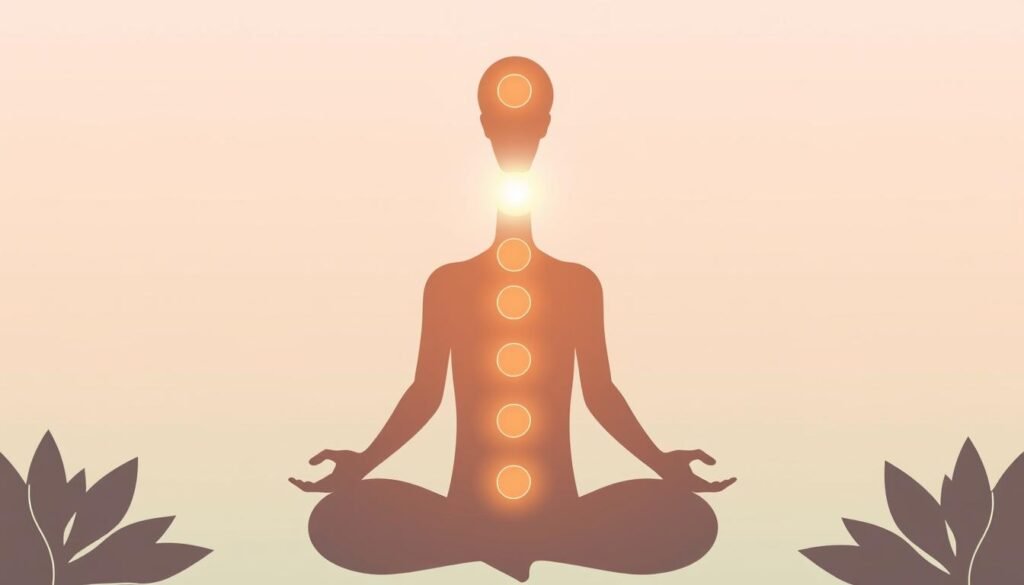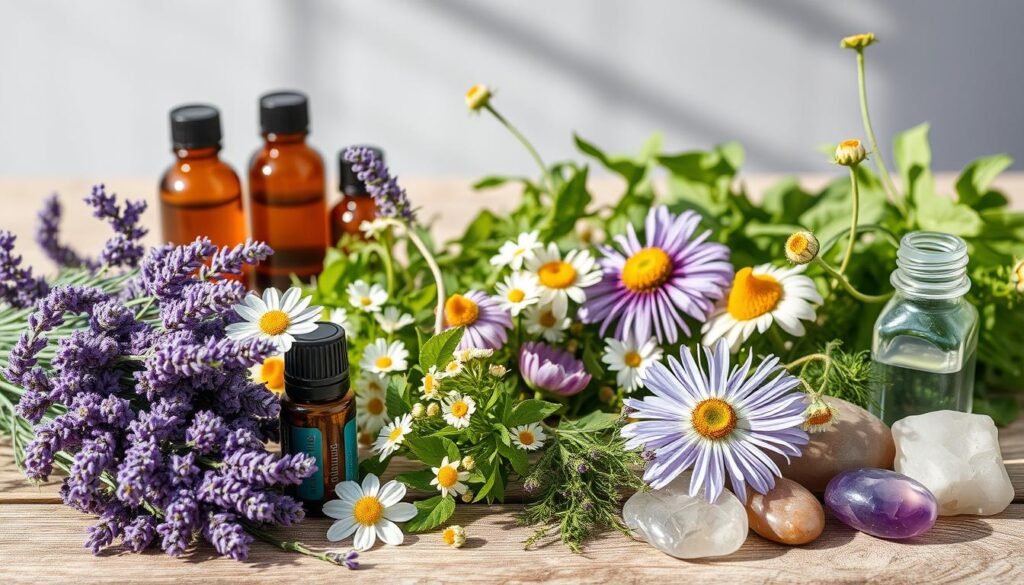About 40 million adults in the United States struggle with anxiety disorders. This reveals how common anxiety is as a mental health issue. Many people are looking for natural ways to handle their anxiety. That’s where acupressure comes in. By pressing certain pressure points for anxiety, one can get temporary relief and feel better overall.
Adding anxiety management techniques like acupressure to your routine can be a good complement to standard treatments. It’s easy to do and has been helpful for many in calming stress and anxiety. In this article, we’re going to look into the top pressure points, where to find them, and how they help your mental health.
Key Takeaways
- Acupressure targets specific pressure points to alleviate anxiety symptoms.
- Applying firm pressure for 30 seconds on pressure points can promote relaxation.
- Combining acupressure with essential oils enhances its effectiveness for stress relief.
- The technique has been shown to ease anxiety before medical procedures.
- Acupressure is a complementary therapy and should be used alongside conventional treatments.
Introduction to Anxiety Relief through Acupressure
In recent years, the rise in anxiety has been notable, often linked to global situations like the coronavirus pandemic. Practices such as acupressure techniques have become popular for holistic anxiety treatment. This method involves pressing specific body points with the thumb to relieve stress and anxiety.
Using these techniques is easy. One effective way is to press and massage each acupoint in small circles. Keeping the pressure for 10 slow breaths before letting go can make this method work better. Different pressure points can help with anxiety, calming the nerves and helping with an overactive sympathetic nervous system.
Points like Shen Men (Heart 7), The Third Eye (Yintang), Pericardium Six, Conception Vessel 17, and Governing Vessel 20 offer quick stress relief. Although more research is needed for chronic anxiety, these points can help immediately in stressful times. Those pregnant or with health issues should talk to a doctor before trying these techniques.
Adding acupressure to anxiety management can also improve mindfulness techniques. For more tips on handling stress, check out this resource. These methods can create a peaceful environment and boost mental well-being significantly.
The Benefits of Using Pressure Points for Anxiety
Acupressure brings natural help for managing anxiety. It targets special pressure points to ease symptoms like muscle tension and headaches. This method promotes a calm mind in tough times.
Benefits of acupressure go beyond just easing symptoms. It boosts the release of endorphins, making you feel better overall. As a part of TCM, it’s been valued for thousands of years.
Acupressure is popular because it doesn’t use needles. You can manage anxiety at home by following simple rules. Don’t press too hard or on injured skin. Keep it up for 30 seconds to three minutes, a few times daily, for the best stress relief.
The table below shows study results backing acupressure’s effectiveness:
| Study Year | Focus Area | Findings |
|---|---|---|
| 2021 | Generalized Anxiety Disorder | Improvements in anxiety symptoms through acupuncture and acupressure |
| 2021 | Yintang Acupuncture | Effective in reducing anxiety in preoperative patients |
| 2017 | Sports Injuries | Acupressure helpful for physical pain, less evidence for anxiety relief |
Acupressure is part of a wider approach to mental health. As a natural remedy for anxiety, it supports traditional treatments. More and more, therapists are using it to help provide full care for anxiety.
Understanding Acupressure and its Relationship to Anxiety Management
Acupressure is a key method for managing anxiety. It uses principles like those in acupuncture. This therapy taps into energy channels, greatly influencing mental health. By pressing certain points, people can deeply relax. Studies back up how well it works. In a big review of 1,110 studies, 39 showed acupressure really helps with anxiety. The data proved it makes a big positive difference.
The impact of acupressure on our bodies is amazing. It wakes up the nervous system, which leads to emotional balance. Key points such as Yin Tang and Heart 7 help reduce anxiety. Doing acupressure a few times daily can lower anxiety noticeably. Even tests with fake acupressure showed it works better than doing nothing.
During the COVID-19 pandemic, over 40% of Americans struggled with mental health. This made it clear that we need better ways to handle anxiety. Acupressure has been around for ages. It’s still a good choice for those seeking natural anxiety remedies. For best results, press each point for three minutes, twice a day. This approach helps tackle anxiety from all sides.

| Key Metrics | Acupressure | Control Group |
|---|---|---|
| Total Studies Reviewed | 1,110 | N/A |
| Studies Included in Meta-Analysis | 39 | N/A |
| Effect Size (SMD) | -5.39 | -0.92 |
| Improvement with Sham Acupressure | SMD -1.61 | N/A |
| Percentage of Increase in Demand for Mental Health Services | Over 93% | N/A |
| Percentage Reporting Adverse Conditions (U.S.) | Over 40% | N/A |
Learning how acupressure helps with anxiety can empower us. It offers a strong way to ease stress and improve emotional health. Through simple practices, we can find lasting calmness and well-being.
7 Most Effective Pressure Points for Anxiety Relief
Every day, many people deal with anxiety and stress. Acupressure offers a promising solution. It uses pressure on specific points to promote relaxation and address health issues. This ancient practice can help one feel calm by tapping into the body’s self-healing abilities.
Hall of Impression Point (Yintang)
The Hall of Impression Point is between the eyebrows. It helps reduce anxiety and stress. Applying gentle circular pressure for 5-10 minutes can make a big difference to your emotional health.
Heavenly Gate Point (Shen Men)
This point is in the upper part of the ear. It eases anxiety and insomnia. Just 2 minutes of stimulation can lower stress and bring peace.
Shoulder Well Point (Jian Jing)
Found in the shoulder muscle, this point relieves muscle tension and headaches. But, be careful when using it during pregnancy.
Union Valley Point (He Gu)
It’s located in the webbing between the thumb and index finger. It helps lessen stress and headaches. A short massage of 4-5 seconds can give quick relief.
Great Surge Point (Tai Chong)
This acupressure point is under where the big toe meets the second toe. It reduces anxiety and helps with insomnia and menstrual cramps, making you more comfortable.
Inner Frontier Gate Point (Neiguan)
Three finger-widths below the wrist is where this point lies. It’s good for lessening anxiety and nausea. This makes it a versatile option for feeling better.
Understanding the Techniques for Stimulating Pressure Points
Here are some techniques that work well:
- Use thumbs, fingers, knuckles, or tools like massage balls to apply steady pressure.
- Deep breathing can help make you more relaxed.
- Staying mindful during the session improves the experience.
Knowing these techniques can help you get the most out of acupressure. This can lead to lasting self-care practices for anxiety.

| Pressure Point | Location | Benefits | Suggested Duration |
|---|---|---|---|
| Hall of Impression Point | Between the eyebrows | Reduces anxiety and stress | 5-10 minutes |
| Heavenly Gate Point | Upper shell of the ear | Alleviates anxiety and insomnia | 2 minutes |
| Shoulder Well Point | Shoulder muscle | Releases tension and headaches | As needed |
| Union Valley Point | Webbing between thumb and index finger | Reduces stress and headaches | 4-5 seconds |
| Great Surge Point | Below the big toe and second toe intersection | Calms anxiety, relieves cramps | As needed |
| Inner Frontier Gate Point | Three finger-widths below the wrist | Reduces anxiety and nausea | As needed |
Complementary Natural Remedies for Anxiety Relief
Anxiety touches many, with over 40 million in the U.S. facing it each year. Natural remedies like acupressure help soothe anxiety.
Herbs are key in fighting anxiety. Chamomile and lavender teas calm the mind, reducing anxiety. Omega-3s from fish oil also lessen anxiety. Including vitamin B and magnesium fights off related depression and anxiety.
People now prefer non-drug treatments for anxiety. They blend well into everyday life. Mindfulness, meditation, and essential oils like clary sage boost emotional health.
Being active is essential too. It not only boosts physical health but cuts down anxiety. Walks in nature are particularly stress-busting.

Cutting back on caffeine and alcohol helps mental health. Less of these means less anxiety. It’s a simple change with big benefits.
These methods offer a full plan for anxiety relief. They empower people to improve their well-being.
Alternative Therapies for Anxiety: Acupressure vs. Acupuncture
Acupressure and acupuncture are both alternative therapies for anxiety. But, they use different techniques. Acupuncture inserts fine needles at acupuncture points for anxiety. This stimulates the nervous system and helps in healing. Acupressure, on the other hand, uses hands to apply pressure on similar points. This is a non-invasive way to relieve anxiety.
Both aim to balance the body’s energy channels. Acupuncture treatments last from 30 to 90 minutes. Acupressure sessions can be shorter and more frequent. Applying pressure to certain points can ease anxiety symptoms.
Many find acupressure a good way to manage anxiety without needles. Studies show that pressure on certain points can reduce anxiety. Acupoints like Yin Tang and Neiguan are known for their calming effects.
Choosing between acupressure and acupuncture depends on personal preference. It also depends on how you feel about needles and your health needs. Talking to a professional can help you find the right treatment for you.
Conclusion
Acupressure is a great way to reduce anxiety by targeting specific points on the body. A 2018 study showed it’s more effective than fake treatments. However, it’s not a cure-all. It’s best used as part of a larger plan that might include professional help.
Studies suggest that combining methods works best for anxiety relief. Acupressure has helped nursing students and those undergoing fertility treatments. But, it’s important to talk to a doctor about severe anxiety. Getting professional advice is key to a full anxiety management plan.
For anyone looking to manage anxiety, acupressure could be beneficial. To learn more, this detailed article on acupuncture for anxiety is a good resource. It covers how acupressure and acupuncture can help improve mental health when included in everyday life.